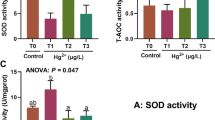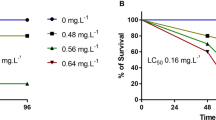Abstract
Bioaccumulation of mercury and histomorphological changes in the olfactory epithelium of Labeo rohita were investigated after exposing the fish to two sublethal concentrations of HgCl2 (66 and 132 μg/L) for 15 and 30 days. Mercury deposition increased in the tissue significantly (p < 0.05) with dose- and duration-dependent manner. Severe damage to the olfactory epithelium was evident. When fish exposed to 66 μg/L for 15 days, the histology of olfactory epithelium exhibited that mucous cell proliferation was upregulated and cell size was significantly increased from the control. Similar trends were found in 30 days exposure in both treated groups. Histology showed that mercury induced degeneration of columnar sensory cells, supporting cells and ciliated non-sensory cells and induced basal cell proliferation. Basal cell hyperplasia led to form intraepithelial proliferative lesion, thickening of epithelium, basal lamina disruption and cyst formation. Scanning electron microscopy revealed that mercury exposure at 66 μg/L caused clumping and loss of cilia, erosion in microridges on the supporting cells and proliferation of mucous cell opening. Complete degeneration of ciliated cells and cyst formation was observed in the fish when exposed to 132 μg/L HgCl2. This result suggests that prolonged exposure to mercury might cause irreversible damage to the olfactory epithelium and impair the olfactory function of fish.






Similar content being viewed by others
References
APHA (2010) Standard methods for the examination of water and wastewater. In: Clesceri LS, Greenberg AE, Eaton AD, 20th edn
Baatrup E, Döving KB (1990) Histochemical demonstration of mercury in the olfactory system of salmon (Salmo salar L.) following treatments with dietary methylmercuric chloride and dissolved mercuric chloride. Ecotox Environ Saf 20:277–289
Baldwin DH, Sandahl JF, Labenia JS, Scholz NL (2003) Sublethal effects of copper on coho salmon: impacts on non-overlapping receptor pathways in the peripheral olfactory nervous system. Environ Toxicol Chem 22:2266–2274
Bettini S, Caini F, Franceschini V (2006) Recovery of the olfactory receptor neurons in the African Tilapia mariae following exposure to low copper level. Aquat Toxicol 76:321–328
Bouquegneau JM (1977) ATPase activity in mercury intoxicated eels. Experientia 33:941–942
Brown SB, Evans RE, Thomson BE, Hara TJ (1982) Chemoreception and aquatic pollutants In T.J.Hara (ed) Chemoreception in fish. Amsterdam Elsevier Press 363–393
Cancalon P (1983) Influence of detergent on the catfish olfactory mucosa. Tiss Cell 15:245–258
Chakrabarti P, Ghosh S (2010a) Histoarchitecture and scanning electron microscopic studies of the olfactory epithelium in the exotic fish Puntius javanicus (Bleeker). Arch Pol Fish 18:173–177
Chakrabarti P, Ghosh S (2010b) Histological and scanning electron microscopical study of the olfactory epithelium of the Indian major carp, Catla catla (Hamilton). Folia Morphol 69:24–29
Clarkson TW (1990) Human health risks from methylmercury in fish. Environ Toxicol Chem 9:821–823
Clarkson TW (1995) Environmental contaminants in the food chain [Review]. Am J Clin Nutr 61:682S–686S
Dalal R, Bhattacharya S (1994) Effect of cadmium, mercury, and zinc on the hepatic microsomal enzymes of Channa punctatus. Bull Environ Contam Toxicol 52:893–897
Dang ZC, Lock RAC, Flik G, Sjord E, Bonga W (1999) Metallothionein response in gills of Oreochromis mossambicus exposed to copper in freshwater. Am J Physiol 277:R320–R331
Denizeu F, Marison M (1990) Toxicity of cadmium, copper and mercury to isolate trout hepatocytes. Can J Fish Aquat Sci 47:1038–1042
Finney DJ (1971) Probit analysis, 3rd edn. Cambridge University Press, Cambridge, pp 25–26
Florea AM, Busselberg D (2006) Occurrence, use and potential toxic effects of metals and metal compounds. Biometals 19:419–427
Ghosh S, Chakrabarti P (2011) Distribution and organization of different cells lining the olfactory epithelium of the Indian minor carp, Labeo bata (Hamilton 1822): a light and scanning electron microscopic analysis. Pak J Biol Sci 14:736–741
Ghosh D, Mandal DK (2012) Histopathological effects and bioaccumulation of mercury in the kidney of an indian major carp, Labeo rohita (Hamilton). Bull Environ Contam Toxicol 89:479–483
Hansen JA, Rose JD, Jenkins RA, Gerow KG, Bergman HL (1999) Chinook salmon (Oncorhynchus tshawytscha) and rainbow trout (oncorhynchus mykiss) exposed to copper; neurophysiological and histological effects on the olfactory system. Environ Toxicol Chem 18:1979–1991
Hara TJ (1992) Mechanisms of olfaction. In: Hara TJ (ed) Fish chemoreception. Chapman and Hall, London, pp 150–170
Hara TJ (2006) Olfactory responses to amino acids in rainbow trout: revisited. In: Reutter K, Kapoor BG (eds) Fish Chemosenses. Science Publishers, Enfield, pp 31–64
Inglis SK, Corboz MR, Taylor AE, Ballard ST (1997) In situ visualization of bronchial submucosal glands and their secretory response to acetylcholine. Am J Physiol Lung C 272:L203–L210
Julliard AK, Saucier D, Astic L (1996) Time–course of apoptosis in the olfactory epithelium of rainbow trout exposed to a low copper level. Tiss Cell 28:367–377
Klaprat DA, Brown SB, Hara TJ (1988) The effect of low pH and aluminium on the olfactory organ of rainbow trout, Salmo gaidneri. Environ Biol Fish 22:69–77
Low KW, Sin YM (1998) Effects of mercuric chloride and sodium selenite on some immune responses of blue gourami, Trichogaster trichopterus (Pallus). Sci Total Environ 18:153–164
MacDougal KC, Johnson MD, Burnett KG (1996) Exposure to mercury alters early activation events in fish leukocytes. Environ Health Persp 104:1102–1106
Mandal DK, Roy D, Ghosh L (2005) Structural organization of the olfactory epithelium of a spotted snakehead fish, Channa punctatus. Acta Ichthyol Piscat 35:45–50
Masud S, Singh IJ, Ram RN (2009) Histopathological responses in ovary and liver of Cyprinus carpio after short term exposure to safe concentration of mercuric chloride and recovery pattern. J Environ Biol 30:399–403
Moran DT, Rowley JC III, Aiken GR, Jafek BW (1992) Ultrastructural neurobiology of the olfactory mucosa of the brown trout, Salmo trutta. Micros Res Tech 23:28–48
Passow HA, Rothstein H, Clarkson TW (1961) The general pharmacology of the heavy metals. Pharmacol Rev 13:185–225
Porcella DB (1994) Mercury in the environment: biogeochemistry. In: Mercury pollution: integration and synthesis. CRC Press, Boca Raton, pp 3–19
Ram RN, Sathyanesan AG (1983) Effect of mercuric chloride on the reproductive cycle of the teleostean fish Channa punctatus. Bull Environ Contam Toxicol 30:24–27
Ray D, Ghosh D, Mandal DK (2012) Induction of metallothionein in the olfactory epithelium of Channa punctatus (Bloch) in response to cadmium exposure: an immunohistochemical study. Proc Zool Soc 65:40–44
Renfro JL, Schmidt-Neilson B, Miller D, Benos D, Allen J (1974) Methyl mercury and inorganic mercury: uptake, distribution and effect on osmoregulatory function in fishes. In: Vernberg FJ, Vernberg WB (eds) Pollution and physiology of marine organisms. Academic Press, New York, pp 101–122
Sandahl JF, Baldwin DH, Jenkins JJ, Scholz NL (2004) Odor-evoked field potentials as indicators of sublethal neurotoxicity in juvenile coho salmon (Oncorhynchus kisitch) exposed to copper, chlorpyrifos, or esfenvalerate. Can J Fish Aquat Sci 61:404–413
Solangi MA, Overstreet RM (1982) Histopathological changes in two estuarine fishes, Menidia beryllina (Cope) and Trinectes maculates (Bloch and Schneider), exposed to crude oil and water-soluble fractions. J Fish Dis 5:13–35
Sutterlin A, Sutterlin N (1971) Electrical responses of the olfactory epithelium of atlantic salmon (Salmo salar). J Fish Res Board Can 28:565–572
Tallkvist J, Henriksson J, d’Argy R, Tjalve H (1998) Transport and subcellular distribution of nickel in the olfactory system of pikes and rats. Toxicol Sci 43:196–203
Tierney KB, Baldwin DH, Hara TJ, Ross PS, Scholz NL, Christopher JK (2010) Olfactory toxicity in fishes. Aquat Toxicol 96:2–26
Weis JS, Weis P (1995) Effects of embryonic exposure to methylmercury on larval prey-capture ability in the mummichog, Fundulus heteroclitus. Environ Toxicol Chem 14:153–156
Zillioux Ej, Porcella DB, Benoit JM (1993) Mercury cycling and effects in freshwater wetland ecosystems. Environ Toxicol Chem 12:2245–2264
Acknowledgments
The authors are grateful to the Head, Department of Zoology, Visva-Bharati University for the facilities provided. This work was supported by University Grant Commission, New Delhi, through RFSMS Fellowship to DG. Thanks are due to Dr. Anshuman Sarkar, Department of Statistics, Visva-Bharati University for his kind assistance during statistical analysis. The authors appreciate the technical assistance for SEM study to the USIC, Burdwan University and for AAS study to the Metallurgy Department, Jadavpur University.
Author information
Authors and Affiliations
Corresponding author
Rights and permissions
About this article
Cite this article
Ghosh, D., Mandal, D.K. Mercuric chloride induced toxicity responses in the olfactory epithelium of Labeo rohita (HAMILTON): a light and electron microscopy study. Fish Physiol Biochem 40, 83–92 (2014). https://doi.org/10.1007/s10695-013-9826-2
Received:
Accepted:
Published:
Issue Date:
DOI: https://doi.org/10.1007/s10695-013-9826-2




